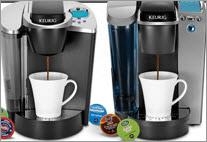 Single-cup brew coffee sales continued their massive growth last year, with dollar sales increasing 82%, to more than $1.8 billion, from $1 billion in 2011, according to a new report on
this coffee segment from Packaged Facts.
Single-cup brew coffee sales continued their massive growth last year, with dollar sales increasing 82%, to more than $1.8 billion, from $1 billion in 2011, according to a new report on
this coffee segment from Packaged Facts.
Packaged Facts projects that single-serve sales will show a compound annual growth rate of 28% to 29% between 2012 and 2016, to reach $5
billion by 2016.
Between 2007 and 2012, single cup's CAGR was an impressive 79% (versus a CAGR of under 6% for ground coffee during the same period).
During that timeframe, the Keurig K-Cup brewer from Green Mountain Coffee Roasters, which has about a 60% share of the market, saw CAGR of more than 75%. (Packaged Facts estimates that
Starbucks has about an 18% share of the single-cup market, and that J.M. Smucker's share, from its Folgers Gourmet Selections and Millstone brands, is about 16%.)
advertisement
advertisement
In 2012, 36% of
consumers surveyed by the National Coffee Association who had a single-serve brewing system reported having purchased it in the last six months, demonstrating just how fast this segment has been
growing.
Single-cup's growth was the major driver of the 10% dollar sales growth in the total U.S. coffee market last year. Within food, drug and mass merchandise channels
(excluding Wal-Mart), total coffee sales grew from $4.5 billion to $4.9 billion between 2011 and 2012, per IRI InfoScan data -- and single-cup coffee accounts for over 20% of those channels' total
coffee sales.
"Proven market performance and the expiration of an important K-Cup patent in September 2012 have driven a new round of competition in the single-cup market,
motivating long-standing category participants to step up their competitive strategies,” observes Packaged Facts research director David Sprinkle. The increased competition includes an
influx of private-label and unlicensed beverage pods that work in Keurig K-Cup brewers, he notes.
New, more sophisticated and specialized machine technology for single-cup brewers
continues to improve the quality of coffee made at home, while single-serve beverage manufacturers and marketers continue to broaden the array of beverages specifically designed for these machines,
increasing the range of successful products, brand entrants and satisfied consumers, the report points out.
Key factors that will continue to drive single-serve growth include:
*A nation of dedicated, increasingly discerning coffee drinkers.
*Consumers' desire to brew coffee shop-quality coffee at home, for both convenience and cost reasons. (A 2013
Harris Poll found that among the one-third of Americans who indicate that they have a single-cup brewing machine at home or work, 70% specifically choose to use it instead of buying a drink from a
coffee shop.)
*Continued adoption of single-serve brewers in offices and hotels.
*Innovations in brewer technology supporting enhanced beverage quality.
*The
large and growing selection of brewers, many of which are aggressively marketed and attractively priced.
*The popularity of single-serve brewers as a hot kitchen gadget, well-suited for
holiday gift-giving.
*The wide and growing selection of single-serve beverage options.
*A growing number of published reports confirming the health benefits associated with
coffee consumption.